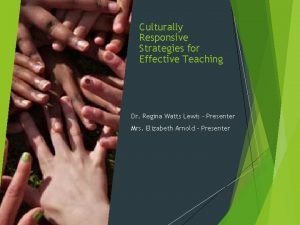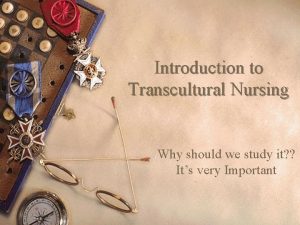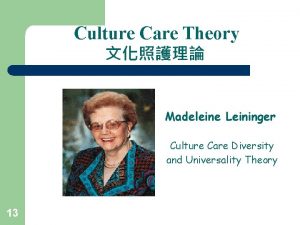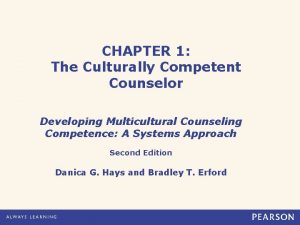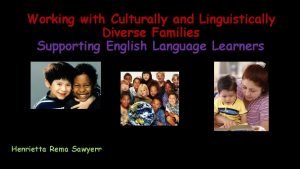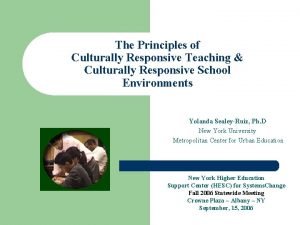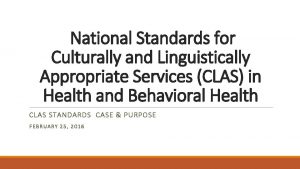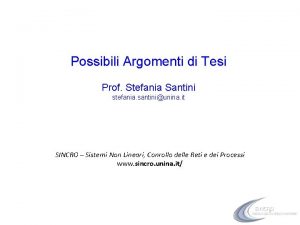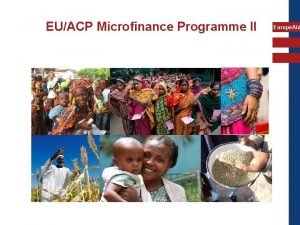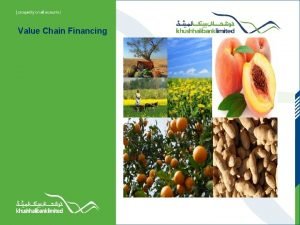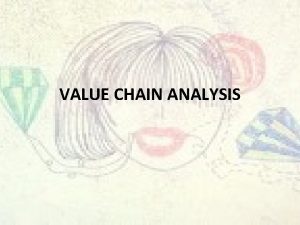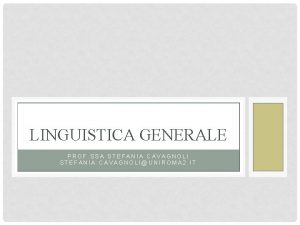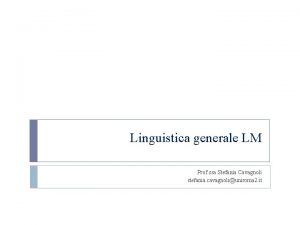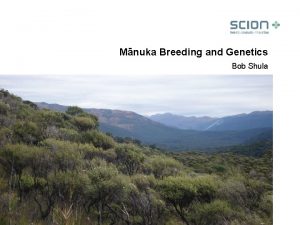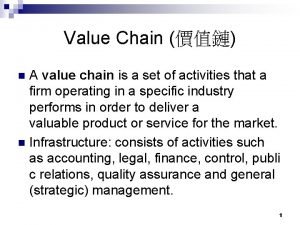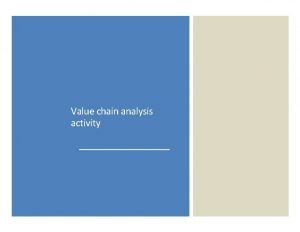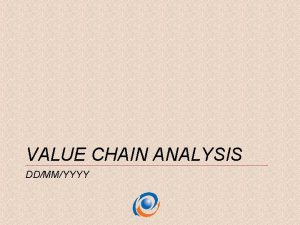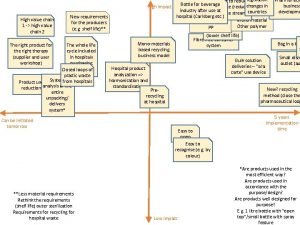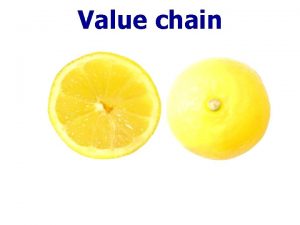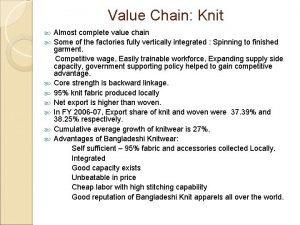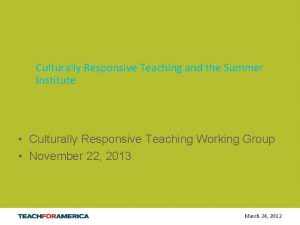A culturally focused Mnuka value chain Stefania Pizzirani



















- Slides: 19

A culturally focused Mānuka value chain Stefania Pizzirani stefania. pizzirani@scionresearch. com Dr. Sarah Mc. Laren Dr. Margaret Forster Dr. Tim Payn Dr. Jeff Seadon Tina Porou Pia Pohatu Tui Warmenhoven

Contents of presentation 1. How Māori culture was represented in the value chain • Cultural indicator matrix • Cultural compliance 2. What are the results of the Mānuka value chain assessment • Environmental • Social • Economic • Cultural January 15, 2022

Case study with Ngāti Porou Aims of the case study: • To explore sustainable alternative types of forestry (Pine, Rimu, Mānuka) • To represent Māori cultural values alongside economic, environmental and social values • To help with the decision making process around forestry options January 15, 2022

Māori and sustainability Morgan, K. B. (2004). “A Tangata Whenua Perspective on Sustainability using the Mauri Model, ” International Conference on Sustainability Engineering and Science, 7 – 9 July 2004, Auckland, New Zealand January 15, 2022

First step to represent Māori culture: Understand Ngāti Porou aspirations and concerns Ngāti Poroutanga (Including Whakapapa , Te Reo, and tikanga) Employment Whanau (family) and Connectedness Mana Motuhake (independent control) Matauranga (information, knowledge, education) Infrastructure Kaitiakitanga and Healthy ecosystems. January 15, 2022 Scion. (2012). Waiapu river catchment study - final report. Rotorua, New Zealand: Scion.

Second step: Develop a way to measure impacts on aspirations 0 Mauri noho Maintaining -1 Mauri heke Diminishing -2 Mauri mate Degrading 1 Mauri piki Enhancing 2 Mauri ora Flourishing Morgan, K. B. (2004). “A Tangata Whenua Perspective on Sustainability using the Mauri Model, ” International Conference on Sustainability Engineering and Science, 7 – 9 July 2004, Auckland, New Zealand January 15, 2022

Third step: Bring it all together Cultural indicator matrix January 15, 2022

Cultural indicator matrix Results for the Mānuka case study January 15, 2022

Cultural indicator matrix Interpreting results Max per process (Flourishing) Enhancing Diminishing Min per process (Diminishing) Max per aspiration (Flourishing) Enhancing Diminishing Min per aspiration (Diminishing) 24 12 -24 Max for Manuka (Flourishing) Manuka (Enhancing) Manuka (Diminishing) Min for Manuka (Degrading) 168 84 -168 January 15, 2022 14 7 -7 14

Cultural indicator matrix Results for the Mānuka case study Mauri noho Maintaining Mauri heke Diminishing Mauri mate Degrading Mauri piki Enhancing Mauri ora Flourishing January 15, 2022

Cultural compliance process The Cultural compliance process is comprised of six aspects (no particular order): 1. Wahi tapu (sacred places): process of identifying all sacred sites in an area of current or potential forestry activity. 2. Cultural monitor: a person designated by Ngāti Porou to be present on site during forestry operations to ensure all activities are performed with cultural sensitivity and respect. 3. Cultural Health and Safety: includes a kaumātua (elder) travelling to the forestry site to bless the area. 4. Marketing: a provision of funds to market the Māori-owned forest and associated timber under a Māori brand therefore establishing Māori timber as a distinctly indigenous product. The intended end result of a Māori brand, similar to that of the Fairtrade brand, is to add value to the product. 5. Kaitiakitanga (guardians/stewards of the land): the long-term dedication of the Māori community to ensure the land is properly maintained and cared for. 6. Benefits to owners: administrative process of distributing financial and cultural (e. g. hunting, food gathering) benefits to land owners. Cultural compliance processes Before ground preparation (year 1) Before planting (year 1) Before harvesting (year 15) Before material processing (year 2) Before product disposal (year 15) CC processes needed 1, 2, 3, 5 1, 2, 5 all 6 4 4

Mānuka value chain 15/01/2022

Selected indicators GHG emissions, Carbon sequestration Return on Investment, total costs Employment (hours) Cultural indicator matrix, Cultural compliance January 15, 2022

Mānuka value chain results Mānuka costs (per hectare over a 15 -year rotation) 5% 0%1% 4% Nursery 5% Site prep Planting Tending Harv/transp 85% Return on Investment (total) Distilling 12. 3% Return on Investment (per year) 0. 82% January 15, 2022

Mānuka value chain results Mānuka employment (hours per hectare over a 15 -year rotation) Nursery 1, 002 2, 176 1 244 1, 059 544 Site prep Planting Tending Harv/transp Distilling Mānuka GHG emissions Mānuka Carbon (in the wood) (kg. CO 2 eq per hectare over a 15 -year rotation) (kg. CO 2 eq per hectare over 55, 000 a 15 -year rotation) 360 24, 394 47, 885 299 101, 641 825, 000 January 15, 2022

Mānuka value chain results Mānuka Cultural Indicator Matrix (per hectare over a 15 -year rotation) Nursery 4 Site prep 14 10 Planting Tending 9 9 10 Harv/transp Max per process (Flourishing) Enhancing Diminishing 14 7 -7 Min per process (Diminishing) -14 Distilling ü Increase in transparency ü Allows articulation of cultural aspirations within a value chain ü Increased potential for informed decision making ü Opportunity to target information January 15, 2022

Mānuka value chain results ü Cultural Compliance Nursery Use and disposal ü Cultural Compliance Site prep ü Cultural Compliance Product Planting Distillation Tending ü Cultural Compliance Harvesting ü Cultural Compliance January 15, 2022

Key messages • Data based on • current prices • current markets • Product part of chain is where the most profit is added • Significant need for more product and market research and development • Cultural Indicator Matrix is an effective way to ensure Māori aspirations are being met • Mānuka value chain seen as ‘enriching’ Māori aspirations • Cultural Compliance transparently shows that cultural needs are met • Potential for marketing and branding January 15, 2022

Questionnaire Any questions or comments? Stefania Pizzirani, 07 343 5649 stefania. pizzirani@scionresearch. com
 Culturally responsive vs culturally relevant
Culturally responsive vs culturally relevant Grazing food chain diagram
Grazing food chain diagram What is logistics management
What is logistics management Contoh value creation adalah
Contoh value creation adalah Culturally deprived definition
Culturally deprived definition Vdoe culturally responsive teaching
Vdoe culturally responsive teaching Culturally responsive teaching and the brain slides
Culturally responsive teaching and the brain slides Culturally congruent care definition
Culturally congruent care definition Theory of culture care diversity and universality
Theory of culture care diversity and universality Culturally responsive teaching in music education
Culturally responsive teaching in music education Culturally responsive classroom management
Culturally responsive classroom management Reach associates
Reach associates Culturally appropriate intervention strategies
Culturally appropriate intervention strategies Culturally competent counselor
Culturally competent counselor Working with culturally and linguistically diverse families
Working with culturally and linguistically diverse families Culturally relevant pedagogy
Culturally relevant pedagogy National culturally and linguistically appropriate services
National culturally and linguistically appropriate services Santini unina
Santini unina Ewa tuwim woźniak
Ewa tuwim woźniak Acp programme
Acp programme
